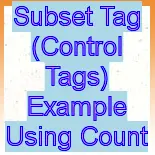Subset Tag (Control Tags) Example Using Count
In this section, we are going to describe the subset tag using the count parameter. The count parameter indicates the number of entries to be set in the resulting subset iterator.
Add the following code snippet into the struts.xml file.
struts.xml
| <action name="subsetTagCount" class="net.roseindia.subsetTag"> <result>/pages/genericTags/subsetTagCount.jsp</result> </action> |
Create a list in the action class and populate it with various items as shown in the "subsetTag" class.
subsetTag.java
package net.roseindia;
|
Now create a jsp page using <s:subset>
and <s:iterator> tags
as shown in the subsetTag.jsp
page. The subset tag takes an iterator and outputs a subset of it. The
parameter count is of integer type and it sets the number of entries to
be kept in the resulting subset iterator.
subsetTagCount.jsp
<%@ taglib prefix="s" uri="/struts-tags" %>
|
Output of Subset Tag:
Output displays only three items because count=3.
 |



